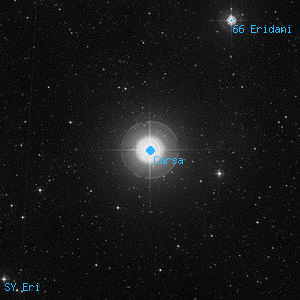Cursa

Overlaid DSS image of Cursa, 60' x 60' with north at top and west to the right
Aladin viewer for the region around Cursa
Beta Eridani, β Eri, 67 Eri
BD-05 1162, HD 33111, HR 1666, WDS J05078-0505, SAO 131794, HIP 23875
BD-05 1162, HD 33111, HR 1666, WDS J05078-0505, SAO 131794, HIP 23875
| Type | Star |
|---|---|
| Magnitude | 2.79 | Right Ascension | 5h 7' 51.0" (2000) |
| Declination | 5° 5' 11" S |
| Constellation | Eridanus |
| Classification | A3IV |
Observing Notes
Andrew Cooper
Oct 25, 2020 Waikoloa, HI (map)
20cm f/6 Newtonian, Cave Astrola @ 76x
Seeing: 7 Transparency: 6 Moon: 25%
Brilliant white, no companion noted, a pretty field of bright stars including 66 Eri 30' northwest and 68 Eri 40' north
Andrew Cooper
Mar 24, 2020 Waikoloa, HI (map)
20cm f/6 Newtonian, Cave Astrola @ 61x
Seeing: 6 Transparency: 7 Moon: 0%
White, no companion noted, 66Eri and 68Eri in the field to the north
Captain William Henry Smyth
Dec 24, 1830 No. 6 The Crescent, Bedford, England (map)
150mm f/17.6 refractor by Tully 1827
A bright star with a distant telescopic companion, on the shin-bone of Orion. A 3, topaz yellow; B 12, pale blue. I examined this object with anxious care, because in Σ.'s first Catalogue, No. 647, A is marked "vicinæ;" and he moreover considered it to be formed of two close stars of the 7th magnitude. All my endeavours, however, could only raise a round disc, and Σ. has since declared it "simplex." This star is readily found from its vicinity to Rigel, being just above it, and in the direction of the Hyades; the poetaster of these matters tells us:Where Rigel shows the Hero's foot,Many writers think this River, which, according to Sherburne, flows over the meridian at midnight in November, was originally intended to typify the Nile, and that the vanity of the Greeks led them to call it Eridanus. By other sage authorities we gather that the river represents either the Spartan Fluviorum rex, or the Po, or the Granicus, or Orion's river, or some other stream; while Ptolemy merely terms it the Ποταμον αστερισμοs, or asterism of the river, which is followed in the Fluvius of the Latins. In the early wood-cut figures of illustrations to Hyginus, Eridanus is represented as a reclining female; while in the MS. of Cicero's Aratus, it is delineated as a river-god, with his urn and aquatic plant. At all events it is one of the old 48 constellations, and its members have been thus successively enumerated:
north-westerly—not far—
Against his leg in glory shines
the River's second star.Ptolemy . . . 34 stars Bayer . . . . . 42 starsThis star is called Cursa, from the Arabic al-kursá, a chair or throne, and is the principal individual of the asterism seen in this hemisphere; α being far down in the south, though not quite at the end of the River, ultima Fluvii, as its name Achernar implies, it being from ákher-nahr, the latter part. It is also called Dhalim, the ostrich, a name given by the Bedawí Arabs, very probably before the Greek constellations were known to their countrymen; and while some called λ, β, ψ Eridani and τ Orionis the Giant's throne, others termed it udh-hí, the little nest, or place in the sand where the ostrich's egg is laid, which, by an error of transcription, became az-ha.
Copernicus . . 34 Bullialdus . . . 39
Tycho Brahd . . 19 Flamsteed . . . 84
Kepler . . . . 39 Bode . . . . . 343― A Cycle of Celestial Objects Vol II, The Bedford Catalogue, William Henry Smyth, 1844
Other Data Sources for Cursa
Nearby objects for Cursa
15 objects found within 120'
| 66 Eridani | 68 Eridani | HD 293815 |
| IC 399 | LDN1616 | NGC 1729 |
| NGC 1740 | NGC 1741 | NGC 1741A |
| NGC 1741B | NGC 1742 | NGC 1753 |
| NGC 1757 | NGC 1788 | SY Eri |
Credits...
Drawings, descriptions, and CCD photos are copyright Andrew Cooper unless otherwise noted, no usage without permission.
A complete list of credits and sources can be found on the about page
Cursa